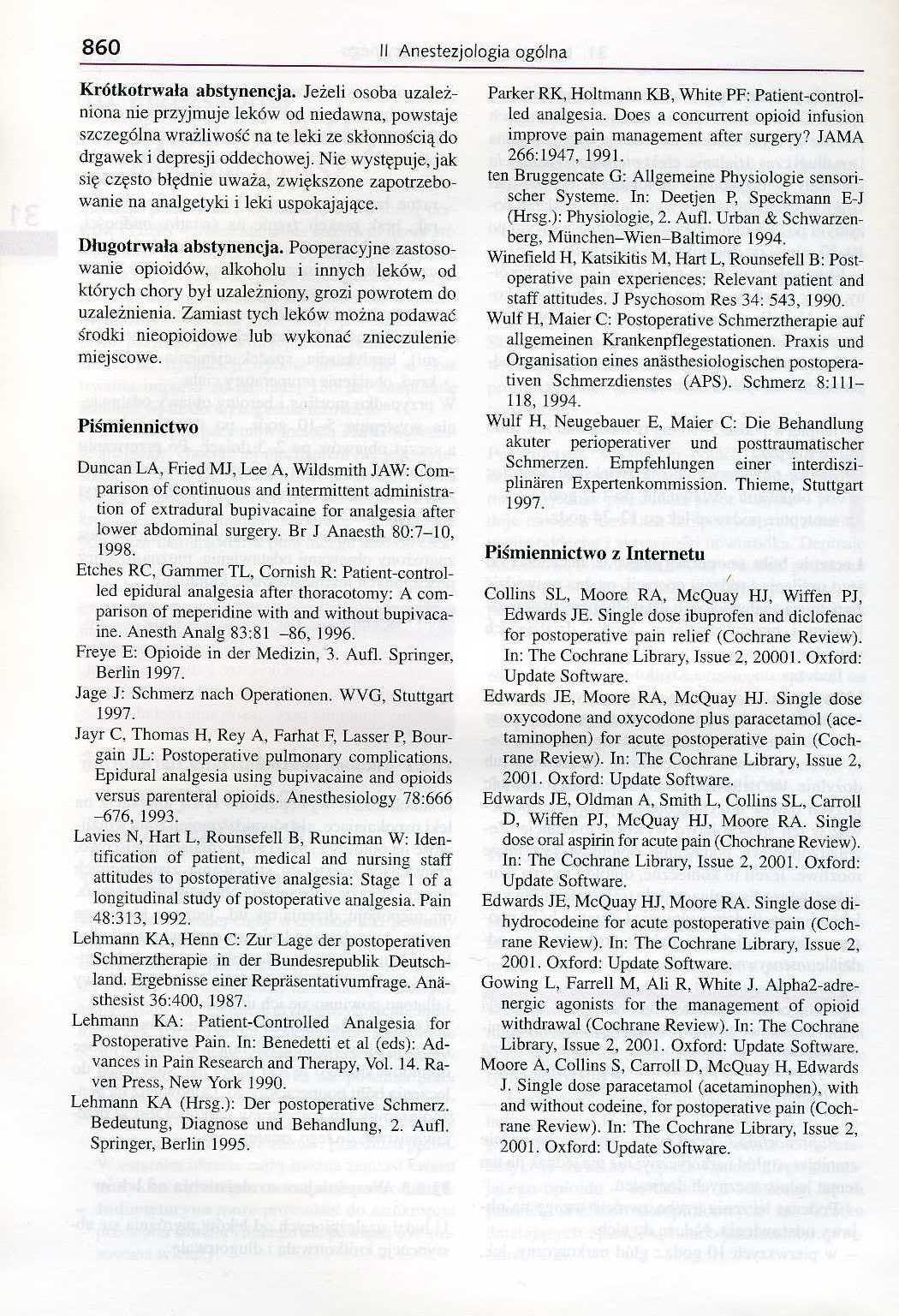larsen0860

860 II Anestezjologia ogólna
Krótkotrwała abstynencja. Jeżeli osoba uzależniona nie przyjmuje leków od niedawna, powstaje szczególna wrażliwość na te leki ze skłonnością do drgawek i depresji oddechowej. Nie występuje, jak się często błędnie uważa, zwiększone zapotrzebowanie na analgetyki i leki uspokajające.
Długotrwała abstynencja. Pooperacyjne zastosowanie opioidów, alkoholu i innych leków, od których chory był uzależniony, grozi powrotem do uzależnienia. Zamiast tych leków można podawać środki nieopioidowe lub wykonać znieczulenie miejscowe.
Piśmiennictwo
Duncan LA, Fried MJ, Lee A, Wildsmith JAW: Com-parison of continuous and intermittent administra-tion of extradural bupivacaine for anatgesia after lower abdominal surgery. Br J Anaesth 80:7-10, 1998.
Etches RC, Gammer TL, Cornish R: Patient-control-led epidural analgesia after thoracotomy: A com-parison of meperidine with and without bupivaca-ine. Anesth Analg 83:81 -86, 1996.
Freye E: Opioide in der Medizin, 3. Aufl. Springer, Berlin 1997.
Jagę J: Schmerz nach Operationen. WVG, Stuttgart 1997.
Jayr C. Thomas H. Rey A, Farhat F, Lasser P, Bour-gain JL: Postoperative pulmonary complications. Epidural analgesia using bupivacaine and opioids versus parenteral opioids. Anesthesiology 78:666 -676, 1993.
Lavies N, Hart L, Rounsefell B, Runciman W: Identification of patient. medical and nursing staff attitudes to postoperative analgesia: Stage 1 of a longitudinal study of postoperative analgesia. Pain 48:313, 1992.
Lehmann KA, Henn C: Zur Lagę der postoperativen Schmerztherapie in der Bundesrepublik Deutsch-land. Ergebnisse einer Reprasentativumfrage. Ana-sthesist 36:400, 1987.
Lehmann KA: Patient-Controlled Analgesia for Postoperative Pain. In: Benedetti et al (eds): Ad-vances in Pain Research and Therapy, Vol. 14. Ra-ven Press, New York 1990.
Lehmann KA (Hrsg.): Der postoperative Schmerz. Bedeutung, Diagnose und Behandlung, 2. Aufl. Springer, Berlin 1995.
Parker RK, Holtmann KB, White PF: Patient-control-led analgesia. Does a concurrent opioid infusion improve pain management after surgery? JAMA 266:1947, 1991.
ten Bruggencate G: Allgemeine Physiologie sensori-scher Systeme. In: Deetjen P, Speckmann E-J (Hrsg.): Physiologie, 2. Aufl. Urban & Schwarzen-berg, Miinchen-Wien-Baltimore 1994.
Winefield H, Katsikitis M, Hart L, Rounsefell B: Post-operative pain experiences: Relevant patient and staff attitudes. J Psychosom Res 34: 543, 1990.
Wulf H, Maier C: Postoperative Schmerztherapie auf allgemeinen Krankenpflegestationen. Praxis und Organisation eines anasthesiologischen postopera-tiven Schmerzdienstes (APS). Schmerz 8:1 liii 8, 1994.
Wulf H, Neugebauer E, Maier C: Die Behandlung akuter perioperativer und posttraumatischer Schmerzen. Empfehlungen einer interdiszi-pliniiren Expertenkommission. Thieme, Stuttgart 1997.
Piśmiennictwo z Internetu
Collins SL, Moore RA, McQuay HJ, Wiffen PJ, Edwards JE. Single dose ibuprofen and diclofenac for postoperative pain relief (Cochrane Review). In: The Cochrane Library, Issue 2, 20001. Oxford: Update Software.
Edwards JE, Moore RA, McQuay HJ. Single dose oxycodone and oxycodone plus paracetamol (ace-taminophen) for acute postoperative pain (Cochrane Review). In: The Cochrane Library, Issue 2, 2001. Oxford: Update Software.
Edwards JE, Oldman A, Smith L, Collins SL, Carroll D, Wiffen PJ, McQuay HJ, Moore RA. Single dose orał aspirin for acute pain (Chochrane Review). In: The Cochrane Library, Issue 2, 2001. Oxford: Update Software.
Edwards JE, McQuay HJ, Moore RA. Single dose di-hydrocodeine for acute postoperative pain (Cochrane Review). In: The Cochrane Library, Issue 2, 2001. Oxford: Update Software.
Gowing L, Farrell M, Ali R, White J. Alpha2-adre-nergic agonists for the management of opioid withdrawal (Cochrane Review). In: The Cochrane Library, Issue 2, 2001. Oxford: Update Software.
Moore A, Collins S, Carroll D, McQuay H, Edwards J. Single dose paracetamol (acetaminophen), with and without codeine, for postoperative pain (Cochrane Review). In: The Cochrane Library, Issue 2, 2001. Oxford: Update Software.
Wyszukiwarka
Podobne podstrony:
larsen0544 544 II Anestezjologia ogólna wany nerw przeponowy (C3-C5), nie ma niebezpieczeństwa wystą
larsen0586 586 II Anestezjologia ogólna ^ Jeśli wynik testu jest ujemny i nie występują objawy zniec
larsen0720 720 II Anestezjologia ogólna wego przepływu krwi i jej pomiar nie jest przydatny podczas
larsen0506 506 II Anestezjologia ogólna Jeżeli obecna jest wydzielina w tchawicy, odessać ją; nie je
larsen0516 516 II Anestezjologia ogólna do tchawicy, a lancę wyciągnąć. Jeżeli nie występuje efekt ś
larsen0580 580 II Anestezjologia ogólna ► Jeżeli wysoką dawkę kwasu acetylosalicylowego (> 1,5 g/
larsen0810 810 II Anestezjologia ogólna średni dostęp do pacjenta, a pacjent, jeżeli to niezbędne, m
larsen0976 976 II Anestezjologia ogólna 8 stanowisk intensywnej terapii, jeżeli w szpitalu nie ma od
larsen0704 704 II Anestezjologia ogólna odłokciowa (zob. ryc. 26.32a). Punkcję tej żyły można wykona
larsen0316 316 II Anestezjologia ogólna - Czy cierpi Pan/Pani na astmę oskrzelową?
larsen0318 318 II Anestezjologia ogólna manych wyników badań nieukierunkowanych są dla oceny ryzyka
larsen0320 320 II Anestezjologia ogólna3.1.3 Elektrolity, mocznik, kreatynina,&nbs
larsen0322 322 II Anestezjologia ogólna znać, gdyż mają one wpływ na anestezjologiczne postępowanie
larsen0324 324 II Anestezjologia ogólna zakresie. Często także należy rozpocząć operację nim nadejdą
larsen0326 326 II Anestezjologia ogólna - przedawkowanie leków, zwłaszcza
larsen0328 328 II Anestezjologia ogólna Dick W, Encke A, Sehuster HP (Hrsg): Pra- und postoperative
larsen0330 330 II Anestezjologia ogólna 3.9.5 Wybór metody znieczulenia...... . 367 6 Choroby
larsen0332 332 II Anestezjologia ogólna - leki przed wary tmiczne, - &
larsen0334 334 II Anestezjologia ogólna Tabela 16.2 Grupy ryzyka krążeniowego wg
więcej podobnych podstron